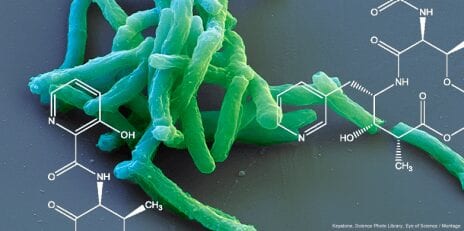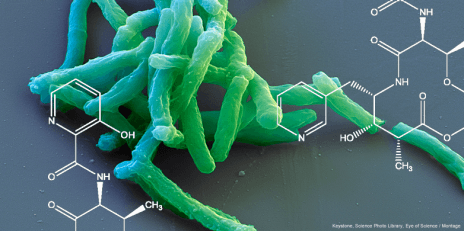In the past 50 years, only one new tuberculosis drug has come on to the market, yet many more active substances are urgently needed.
Current treatments increasingly fail due to multidrug-resistant pathogens. ETH researchers have now applied to patent a novel approach for developing new tuberculosis drugs.
Consumption was one of the worst known diseases of the 18th century. Thanks to medical advances, the number of deaths from this lung disease – which is today known as tuberculosis – has declined significantly. Efforts to eradicate the disease in the 1950s and 1960s resulted in a wide range of new drugs entering the market.
And yet 1.4 million people still continue to die each year from tuberculosis. Multidrug-resistant strains of the disease-causing pathogen are especially dangerous because they can no longer be treated with today’s drugs (see box). “In the past 50 years, only one new tuberculosis drug has come on to the market, and that was in 2012,” says Karl-Heinz Altmann, Professor of Pharmaceutical Biology at ETH Zurich. New active substances that are able to kill multidrug-resistant strains of the disease are therefore urgently needed. Altmann and his team have now laid the foundation for new tuberculosis drugs, and they were inspired by a bacteria-derived antibiotic called pyridomycin.
Learn more . . .
The Latest on: Tuberculosis drugs
[google_news title=”” keyword=”Tuberculosis drugs” num_posts=”10″ blurb_length=”0″ show_thumb=”left”]
via Google News
The Latest on: Tuberculosis drugs
- Ludhiana tuberculosis centre running short of drugson May 9, 2024 at 10:25 am
State TB officer Dr Rajesh Bhargav acknowledged the shortage of drugs across the state. The drugs come to the state health department from the Union ministry of health and family welfare. But, for now ...
- Non-supply of TB medicines hits patients in Rayagada, Ganjam districtson May 8, 2024 at 7:59 pm
BERHAMPUR: Non-supply of medicines for treatment of tuberculosis for the last over a month in Ganjam and Rayagada districts have put the patients in a tough situation. Sources said the Centre, under ...
- Tuberculosis in California: Outbreak declared in Long Beach, 1 dead, 9 hospitalizedon May 8, 2024 at 11:06 am
So far 14 tuberculosis cases have been detected and health department staff have also identified an additional 170 people who have been exposed.
- Drug shortage could lead to TB epidemicon May 7, 2024 at 4:16 pm
Government and private doctors warn of a potential TB epidemic outbreak due to acute shortage of lifesaving drugs for tuberculosis treatment. Urgent action is needed to address the dire situation and ...
- Shortage Of TB Medicines: Patients Rely On Double Dose Of Paediatric Medicines To Fight Tuberculosison May 7, 2024 at 2:15 pm
Acute shortage of regular medicines has forced more than 2,700 patients in Indore to turn to paediatric medicines’ double dose to fight tuberculosis.The scarcity is already two months old with no ...
- GSK commits to further support of BioVersys’ TB drugon May 7, 2024 at 4:01 am
Alpibectir was developed in a public-private collaboration between GSK, Pasteur Institute Lille, and the University of Lille, and is designed as a companion to ethionamide (Eto), which is an important ...
- Public Health: 2 new drug-resistant TB cases on Guam, 3rd person being treated for relapseon May 5, 2024 at 10:55 pm
The Department of Public Health and Social Services has identified two new multidrug-resistant tuberculosis cases, while a third person on Guam is being treated for a relapse of the disease.
- Tuberculosis outbreak declared public health emergency in Long Beach, but overall risk remains low, officials sayon May 3, 2024 at 1:25 pm
In its investigation of the outbreak, the city health department has identified about 170 people who have probably been exposed to tuberculosis. But overall, “the risk of TB for people who live, work, ...
- Long Beach health officials declare tuberculosis outbreak a public health emergencyon May 2, 2024 at 10:13 pm
The World Health Organization says the number of people infected with tuberculosis, including the kind resistant to drugs, rose globally for the first time in years in 2021. Oct. 27, 2022 Davis said ...
- A month on, still no TB drugs in govt, pvt storeson April 28, 2024 at 4:14 pm
Nagpur: Govt hospitals and distribution centres have completely run out of tuberculosis (TB) drugs; 3 FDC (fixed dose combination) and 4 FDC strips, d.
via Bing News












